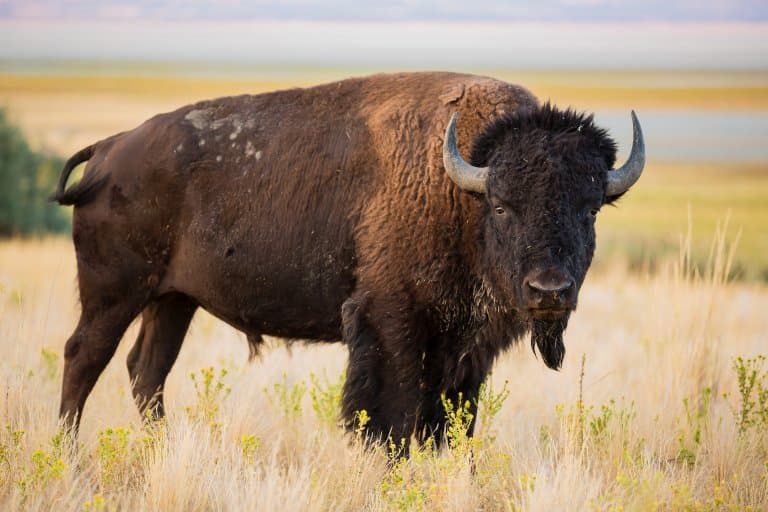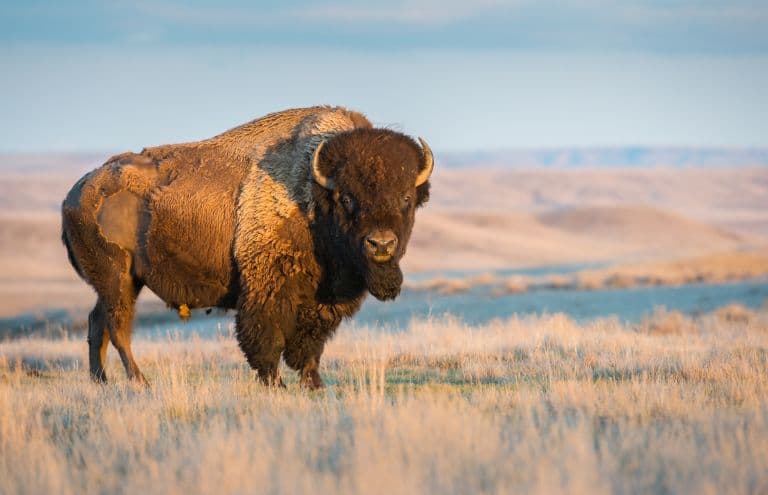There’s a common acceptance of the synonymous usage of “buffalo” and “bison”, and frankly, we think it needs to stop.
It’s perhaps not surprising that it comes from the same part of the world that changed the meaning of the word “literally” to its exact opposite: “figuratively”, but you’d think that a country with the Bison as the national animal would at least be able to get its name right.
The humble buffalo is the National animal of Vietnam and they would never think to call it a bison, but, why not? What exactly is the difference?

Let’s find out the differences between bison and buffalo.
1. Buffalo aren’t native to the US
Despite having multiple locations named after them in the US and Canada (over 30), there’s no record of a wild buffalo species ever setting foot on the continent.
The two buffalo species recognised are the African Cape buffalo, Syncerus caffer, and the Asian water buffalo Bubalus arnee. The former has never been domesticated on account of it being a raging maniac (more on that later), but the Asian water buffalo does have a domesticated descendent known as Bubalus bubalis.
These two (or three, depending on how you look at it) species are closer related to one another than they are to other bovids, including the American bison (Bison bison) and its European cousin the wisent (Bison bonasus).
So, the first difference is that there are two species of each, one pair native to North America and Europe, the other native to Asia and Africa.
In American English, where the rules of language aren’t considered all that important, both “buffalo” and “bison” are acceptable terms for the American bison, but this just won’t fly with taxonomists! 1
2. You can’t wash your hands in a buffalo
For wild species, at least, there’s quite a difference in temperament between bison and buffalo. In Africa, while home to some of the most iconic predators in the world, it’s the large herbivores that pose more of a threat to people.
Among them, the buffalo is one of the most dangerous. African cape buffalo kill around 200 people a year, compared with around 70 deaths attributed to lions.
Compare this with the 2 people killed in the US by bison between 1978 and 1992 (and this is despite the selfie-stick-wielding tourists who often approach them deliberately – and you’ll see that there’s a distinct contrast in the tolerance of the two species.
African buffalo are so aggressive they’re also nicknamed “Widowmakers” and “The black death”.
Bison, despite being immensely powerful, are far remarkably tolerant of human presence.
Now, you’d think this meant the bison would be easier to domesticate, but various attempts at doing so have been met with little success. While tolerant, bison are particularly stubborn animals and refuse to play ball.
Ironically, it was a buffalo species, the Asian water buffalo, that relented to humanity’s attempts to domesticate it. 2
3. Buffalo are Bigger
Bison are formidable animals. They’re essentially meaty snow shovels with an incredible hump to support and push their flat, powerful skulls through the snow to uncover frosty plants in the winter.
They are incredible beasts, but they’re still significantly smaller than buffalo. An absolute tank of a bison might reach around 900kg (2,000lb), but a chunky boi Asian buffalo can exceed 1,200 kg (2,600lb) in mass.
The domestic variant and the African buffalo are both smaller, both similarly weighted to the bison, but they’re not as stocky and are generally longer, taller animals.

4. Bison are cold weather specialists
Both African and Asian buffalo occupy hot, tropical environments, and are well adapted to such. In contrast, the bison is a descendent of the Pleistocene Steppe; a barren, cold wasteland that produced some of the toughest animals around.
So, each has its relevant adaptations. Both water buffalo and cape buffalo spend a lot of time in and around water. They often need to cool off, so they have sparse, thin hair and longer limbs.
Bison live in areas where water becomes solid during the winter, so they’re more adapted to this frigid weather. As such, they have shorter limbs, and thick, shaggy fur and everything’s generally more compacted to lose less heat.
4. Bison have the hump
This ability to of bison drive snow and clear the frosty ground requires immense musculature, and this presents itself as a large hump behind the head.
Buffalo don’t have one of these and are much more traditionally cow-shaped as a result.

5. Buffalo are hornier
Buffalo both have wide horns. The classic African buffalo horn look resembles that of those ridiculous judicial wigs in the British legal system. It has a bony, ridged plate between its horns, which are long and curve down and away from one another before curving back at the ends.
The water buffalo is similar, but without this plate, and the horns tend to curve down less.
Regardless, both arrangements are distinct from the horns of a bison, which are much shorter and tend to protrude at right angles to the head before curving upwards.
To put some figures on this, an African buffalo horn might be up to 1.6 meters long; a water buffalo might sport some as long as two meters, and a bison would be lucky to reach 60cm in length.
6. Bison handle the forest better
Being horny can be a lot of fun out on the plains, but when you start playfully galivanting through the thickets, you might find you start getting snagged.
Modern humans have pretty much wiped out the majority of forests in North America and Europe, but ancestral bison would have been very comfortable among them. The wisent still prefers wooded areas, currently limited to a small population in Polish forests.
In contrast, buffalo in Africa are generally plains animals, though there is a smaller subspecies known as the forest buffalo – and wouldn’t you know it – they are much smaller with (relatively) dinky little horns.
Water buffalo, as the name suggests, are more comfortable in estuarine regions than thickly forested ones.
7. Buffalo live longer
Perhaps this is a testament to the harshness of the Bison’s environment, but they don’t last as long as buffalo in the wild.
Despite having no natural predators – all the lions and cheetahs in North America have long since gone extinct – bison live in some exceptionally hard places. While most other animals migrate out to survive, bison stick around.
And this likely takes its toll. Bison live up to around 21 years in the wild. Contrastingly, a healthy buffalo, despite its plethora of natural predators, might last up to 30. 3
Final thoughts
So there you have it – bison versus buffalo!
Buffalo are two (perhaps three, if you count the domestic one) species of enormous cow found in Africa and Asia. They have wide horns and at least in Africa, they’re hyper-aggressive.
They’re suited for wide plains and watery habitats and adapted to hot, humid environments.
In contrast, buffalo are two species of stocky, cold weather, forest specialists from North America and Europe; entirely unrelated to the buffalo, and distinctly different-looking, with smaller horns, shorter legs and a thick, humped neck.
Both branches of animal are incredible beasts and have played a key role in human evolution and development, and both deserve respect accordingly, as well as recognition for being some of the few remaining mega-herbivores we have.
If you’re still struggling, one final way to tell them apart might be to deliberately get their names wrong. Bison don’t care all that much about being mislabelled, but walk up to a cape buffalo and call it a bison and see what happens.
